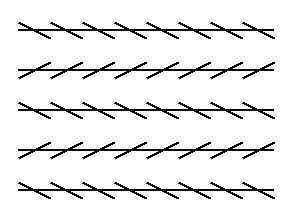A "gravity hill" is one where a downhill slope appears to be uphill, such that an object such as a car will appear to roll uphill when in fact it is moving downhill.
This is described in a wikipedia article as a feature of the lie of the surrounding land.
What relevant feature of the land would cause this misperception/illusion in human beings? I assume it’s related to some aspect of vision, but would have thought our proprioceptors would feed us opposing information, inducing discomfort of some kind.
What is the biological basis of this illusion?
Edited to add my research: the phenomenon is explained here as a gentle decline between two steeper declines. The illusion is explained as comparable to the Zöllner illusion in which lines intersected by oblique line segments appear to tilt (Kitaoka, 2007; Oyama, 1960; Robinson, 1972/1988; Zöllner, 1860).
The American Psychological Association’s definition of the Zollinger illusion is
a visual illusion in which parallel lines appear to diverge when one of the lines is intersected by short diagonal lines slanting in one direction, and the other by lines slanting in the other direction.
The illusion in 2 dimensions is clear. But how does that translate into the 3D illusion? Are the “parallel lines” the edges of the road? Or is the road the line (visually implied) transacted by oblique angles of the landscape?
If That question is confusing, it’s because I am confused. Sorry.
This is not original to me but the original poster chose to leave in a huff. Now I really want to know, because when I was a girl, my mom told me great stories about the strange things she herself had experienced. One of the stories involved being pulled uphill in a car placed in neutral at the bottom of a hill. TIL… it was true, for her at least!

